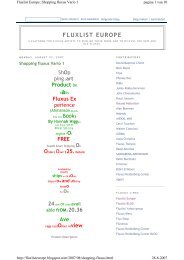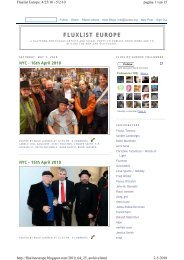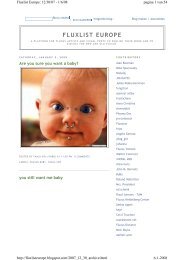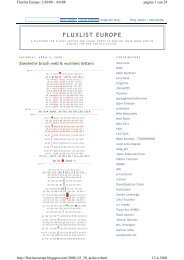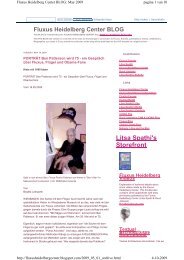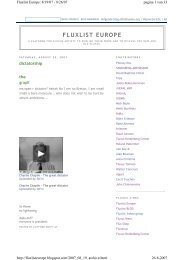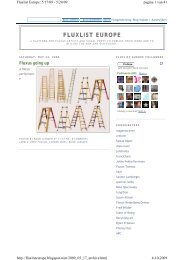The Fluxus File - Fluxus Heidelberg Center
The Fluxus File - Fluxus Heidelberg Center
The Fluxus File - Fluxus Heidelberg Center
Create successful ePaper yourself
Turn your PDF publications into a flip-book with our unique Google optimized e-Paper software.
BroadStrokes Vol. II Issue 6<br />
‘<strong>The</strong> <strong>Fluxus</strong> <strong>File</strong>’<br />
(A didactic drama in three acts)<br />
by Arthur Six<br />
‘A <strong>Fluxus</strong> Folder’ — What is ‘fluxus’? — A Self-Tutorial<br />
ACT I Sayings, Epigrams, and Witticisms (aka ‘fluxus fodder,’ flotsam and fecundity,<br />
or, “You, Sir, are no ‘fluxist.’ ”)<br />
Scene 1 (enter art6 ‘stage left’: come in from the backdoor alley or look down from skylight, mezzanine or balcony inquiringly)<br />
Querulus: Who’s to say what’s ‘fluxus’?<br />
Riposto: Who’s to say what’s not ‘fluxus’?<br />
“. . . aaaannd . . . scene!”<br />
ACT II Issues of Context and Narrative — Three ‘Mitzi’ Scenarios
ACT III Temporality, Media and Message (Mixed and Multi)—Riposto’s Monologue:<br />
“Much of understanding ‘fluxus’ lies in an awareness of multiple, on-going or concurrent mixed and<br />
multimedia—the graphic visual arts, theatre and performance, music and dance, poetry and prose—<br />
nothing is excluded or inherently taboo from the fluxist’s palette and vision—creatively and<br />
artistically commingled with elements of documented, pre-recorded, or real-time materials and<br />
composition. In a way, ‘fluxus’ seeks out interesting, atypical, and often skewed juxtapositions of<br />
seemingly incongruous things in order to find some continuity, thesis, or distinct ‘artistic auteurship.’<br />
A good way to think about ‘fluxus’ is that something as seemingly as trivial as paper ephemera or<br />
ambient, incidental sound and noise may have just as much import and place as something supposedly<br />
grander and (conventionally and traditionally) more profound—like painting or performance.<br />
‘<strong>Fluxus</strong>’ and the ‘<strong>Fluxus</strong>’ movement—due to their democratic demographic and dispersion through<br />
media such as the U.S. mail, small letterpresses, and the modern copier machine—owe perhaps as<br />
much to the work of such disparate, ‘regional’ artists as Louise Neaderland, Stephanie Brody<br />
Lederman, the late Davi Det Hompsom (David E. Thompson), Caryl Burtner, Mitzi Humphrey,<br />
and others as they do to more well-known icons such as Marcel Duchamp, Man Ray, Moholy-Nagy,<br />
Rene Magritte, Robert Rauschenberg, George Maciunas, John Cage, Yoko Ono, Andy Warhol,<br />
Lucas Samaras, Nam Jun Paik, Jenny Holzer, Gary Hill, Laurie Anderson, et al.” Finis TMH<br />
<strong>Fluxus</strong> Artists and Collaborators Not in ReCollage (Many of the ReCollage artists are also<br />
participating in other events and exhibitions of <strong>Fluxus</strong> Redux): Jimmy Warner, Andy Coppola,<br />
Caryl Burtner, Thomas M. Humphrey, Barbara Brown, TANGO, <strong>The</strong> Paper Shredder, Art*O*Mat*,<br />
<strong>Fluxus</strong> Driven, ISCA, Louise Neaderland, Lucy Lippard, Stephanie Brody-Lederman, Yuki<br />
Dixon, Michael Sulsona, R. (Ron) Eugene Brown, Polka Dot Arts, Lew Bailes, Lynn Bailes,<br />
AND MORE!<br />
As well as the <strong>Fluxus</strong> ReCollage Mail Art Project, other ‘Re-Flux’ coming up in July include a<br />
second postcard workshop with instructor Mim Golub; a bumper-sticker bonanza featuring<br />
a van bedecked in bumper-stickers by art6 artist Andy Coppola; a display of ISCA art<br />
destined for donation to the VCU Cabell Library Collection; <strong>The</strong> Paper Shredder (to which<br />
the public is invited to shred their own paper evidence, secrets, and detritus throughout July);<br />
installations by Caryl Burtner, Lew Bailes, Mitzi Humphrey, and Michael Sulsona; Polka Dot Arts<br />
installation of drumhead mandalas, and the ever-popular Art*O*Mat with examples of<br />
dispensed art and the Art*O*Mat Calendar. <strong>The</strong> gallery will use its DVD player and TV recently<br />
donated by Henrietta Near, Willie Anne Wright, and Mitzi Humphrey to show experimental<br />
works by filmmakers Maura Pond and Todd Raviotta as well as videos from the art6 archives.<br />
Also: Saturday, July 9, 8pm—“Not the Beaten Track”—with musicians Ann Archer, Hal Carle,<br />
Heather Fairbanks, and Francis Church, Free. Wednesday, July 20, 8pm— Experimental, improv<br />
music event featuring N.Y. musicians Audrey Chen, Tatsuya Nakatani, and Susan Alcorn—with<br />
opening act, jazz and improv musician Darius Jones, $5. Sunday, July 24, 4pm—Darius Jones<br />
and the Elizabeth Caroline Unit, featuring opera singer Sara Dyson, $5.<br />
For more about this exhibition and other upcoming art6 events, visit www.art6.org or phone 804.343.1406. To<br />
contact the editor of art6 and BroadStrokes, phone Thomas M. Humphrey at 804.794.7579. art6 is located at 6<br />
East Broad Street, Richmond, Virginia 23219. Gallery hours are Wed.-Sun. 12-4pm. -–We invite you to attend.
ReCollage Artists in <strong>Fluxus</strong> Redux at art6, July 2005. Participants in this fluxus mail art project cocurated<br />
by Mitzi Humphrey and Virginia Tyack include originators (artists who began each series of<br />
six cards and tracked its progress) and collaborators (artists who added to individual cards begun<br />
by the originators). Originators were Virginia Tyack, Henrietta Near, Marian Hollowell, Susan<br />
Svendsen, Cynthia Erdahl, Rita Root, Tricia Pearsall, Diego Sanchez, Santa Sergio Dehaven,<br />
Kathleen Westkaemper, Josiah Pearsall, and Mitzi Humphrey. <strong>The</strong>re will be a silent auction of the<br />
ReCollage cards throughout the show. Minimum bid is $10, and subsequent bids must be in<br />
increments of $5. Proceeds will benefit art6.<br />
Collaborators in the <strong>Fluxus</strong> ReCollage Mail Art Project: Cynthia King, Jennifer Yane, Lynn B.<br />
Stevens, Ana Edwards, Keithly Pierce, Georgia Terry, Julia Hauser, Penny Hanky, Kim Winters, John<br />
Bailey, Jesse Bailey, Art Bailey, Caleb Doody, Frances Wessells, Bret Payne, Mim Golub, Julie Wolfe,<br />
Curry Wolfe, Pam Shelor, Becky Jessee, Sara Jessee, Barry C. Fuchs, Andrew Felty, Angie Sturm,<br />
Cassady Rosenblum, Dana Frostick, Sheryl Humphrey, Edward Coppola, Sophia Pulkoski-Skeans,<br />
James Gilchrist, Celeste Ray, Marki Brown, Lynne Haas, Andrew Campbell, Debbie DaPrano, Mary<br />
Holland, Rob Carter, Isabel Scarpino, Amanda Reed, Chris Palmer, Eileen Kindle, Priscilla Busse,<br />
Lisa Kellner, Anonymous Was a Woman, Nancy Strube, Henry Leister, Laura Chessin, Brenda<br />
Giannini, J. M. Lucas, Jim Panos, Ida Navickis, Jeanne Minnix, Adam Courville, Becca Ladmer,<br />
Eileen Kindle, Emily Blake, Austin Tribble, Ann Mason Rumble, Laura Robertson, Sara Jones, Shann<br />
Palmer, Kathleen Forman, W. Kaplowitz, Kathy Levine, and Sandy Wheeler.
A few of the postcards from the ReCollage Mail Art Project, curated by Mitzi Humphrey and Virginia Tyack<br />
Ars longa vita brevis: Franklin Furnace regrets to announce the passing of Sharon Gilbert,<br />
a dedicated collage artist and book maker, some of whose books are shown in the ISCA<br />
collection of <strong>Fluxus</strong> Redux. Also, memorial gifts to art6 have been received in honor of<br />
Mitzi Humphrey’s mother (and BroadStrokes Editor Thomas M. Humphrey’s<br />
grandmother), Alta Ferguson Greene. She was followed in death two weeks later by her<br />
husband, father and grandfather of Mitzi and Thomas, Sterling Augustus “Gus” Greene.<br />
Additional memorial gifts to art6 have been received honoring longtime printmaking<br />
teacher at the Virginia Museum of Fine Arts, Marilyn Bevilaqua, and in memory of artist<br />
Jane Ware’s husband, Winslow Ware. art6 further extends condolences to Starr Foster of<br />
<strong>The</strong> Starr Foster Dance Project, whose father died in May. We were also saddened to hear<br />
of the passing of architect James Glavé, who conducted one of the first ‘walk-throughs’ of<br />
our gallery building at 6 East Broad Street.
<strong>Fluxus</strong> (from "to flow") is an art movement noted for the blending of different artistic disciplines,<br />
primarily visual art but also music and literature. <strong>Fluxus</strong> was founded in 1962 by George Maciunas<br />
(1931-1978), an Lithuanian-American artist who had moved to Germany to escape his creditors. Besides<br />
America and Europe, <strong>Fluxus</strong> also took root in Japan. Among its members were Joseph Beuys, John<br />
Cage, and Yoko Ono who explored media ranging from performance art to poetry to experimental music<br />
to film. <strong>The</strong>y took the stance of opposition to the ideas of tradition and professionalism in the arts of their<br />
time, the <strong>Fluxus</strong> group shifted the emphasis from what an artist makes to the artist's personality, actions,<br />
and opinions. Throughout the 1960s and '70s (their most active period) they staged "action" events,<br />
engaged in politics and public speaking, and produced sculptural works featuring unconventional<br />
materials. <strong>The</strong>ir radically untraditional works included, for example, the video art of Nam June Paik and<br />
the performance art of Beuys. <strong>The</strong> often playful style of <strong>Fluxus</strong> artists led to their being considered by<br />
some little more than a group of pranksters in their early years. <strong>Fluxus</strong> has also been compared to Dada<br />
and is seen as the starting point of mail art. Most notorious are the <strong>Fluxus</strong> performance pieces or "Event<br />
Scores." <strong>Fluxus</strong> artists differentiate Event Scores from "Happenings." Whereas happenings were meant to<br />
blur the lines between performer and audience, performance and reality, <strong>Fluxus</strong> performances were oneliners<br />
and sight gags. <strong>The</strong> performances sought to elevate the banal and dissemble the high culture of<br />
serious music. Marcel Duchamp and Robert Rauschenberg were highly influential to <strong>Fluxus</strong>. [source:<br />
en.wikipedia.org]<br />
Jason II, 1962/80, Joseph Beuys John Cage<br />
<strong>Fluxus</strong> — An art movement begun in 1961/1962, which flourished throughout the 1960s, and into the<br />
1970s. Characterized by a strongly Dadaist attitude, <strong>Fluxus</strong> promoted artistic experimentation mixed with<br />
social and political activism, an often celebrated anarchistic change. Although Germany was its principal<br />
location, <strong>Fluxus</strong> was an international avant-garde movement active in major Dutch, English, French,<br />
Swedish, and American cities. Its participants were a divergent group of individualists whose most<br />
common theme was their delight in spontaneity and humor. <strong>Fluxus</strong> members avoided any limiting art<br />
theories, and spurned pure aesthetic objectives, producing such mixed-media works as found poems, mail<br />
art, silent orchestras, and collages of such readily available materials as scavenged posters, newspapers,<br />
and other ephemera. <strong>The</strong>ir activities resulted in many events or situations, often called "Aktions"—works<br />
challenging definitions of art as focused on objects—performances, guerilla or street theater, concerts of<br />
electronic music—many of them similar to what in America were known as “happenings.” In Latin and<br />
other languages, "<strong>Fluxus</strong>" literally means "flow" and "change." Similarly, the related English word "flux" is<br />
used variously to mean "a state of continuous change," "a fusion," and "a gushing of fluid from a body."<br />
George Maciunas (Lithuanian-American, 1931-1978) coined the name <strong>Fluxus</strong>. He described it as "a fusion<br />
of Spike Jones, gags, games, Vaudeville, Cage and Duchamp." He coordinated and edited numerous<br />
<strong>Fluxus</strong> publications. According to George Maciunas, <strong>Fluxus</strong> intended to "purge the world of bourgeois<br />
sickness . . . of dead art," to "promote a revolutionary flood and tide in art, anti-art, promote non art<br />
reality . . ." and to "fuse the cadres of cultural, social, and political revolutionaries into a united front and<br />
action." [source: www.artlex.com]
<strong>The</strong> <strong>Fluxus</strong> movement emerged in New York in the 60's, took root in Europe, and eventually made its way to<br />
Japan. <strong>The</strong> movement embraced a new aesthetic that had already appeared on three continents. That aesthetic<br />
encompasses a reductive gesturality (part Dada, part Bauhaus and part Zen) and presumes that all media and all<br />
artistic disciplines are fair game for combination and fusion. <strong>Fluxus</strong> presaged avant-garde developments over the<br />
last 40 years.<br />
<strong>Fluxus</strong> objects and performances are characterized by minimalist but often expansive gestures based in scientific,<br />
philosophical, sociological, or other extra-artistic ideas and leavened with a sense of burlesque.<br />
Yoko Ono may be the best-known individual associated with <strong>Fluxus</strong> (because of her obvious high-profile union<br />
with one of the most famous individuals in the world), but many artists have associated themselves with <strong>Fluxus</strong><br />
since its emergence. In the '60s, when the <strong>Fluxus</strong> movement was most active, artists all over the globe worked in<br />
concert with a spontaneously generated but carefully maintained <strong>Fluxus</strong> network. Since then, <strong>Fluxus</strong> has endured<br />
not so much as a movement but as a sensibility—a way of fusing certain radical social attitudes with ever<br />
evolving aesthetic practices. Initially received as little more than an international network of pranksters, the<br />
admittedly playful artists of <strong>Fluxus</strong> were, and remain, a network of radical visionaries who have sought to change<br />
political and social, as well as aesthetic, perception.<br />
<strong>Fluxus</strong>—as well as being influenced by and incorporating many interdisciplinary arts, humanities, and<br />
endeavors—also drew from, imbued, and in no small way, informed the existential, absurdist, left-of-center<br />
literature of writers such as Charles Baudelaire, Arthur Rimbaud, Jean-Paul Sartre, Albert Camus, George Orwell,<br />
Franz Kafka, Vladimir Nabokov, Andre Breton, Jean Genet, Eugene Ionesco, Samuel Beckett, Dylan Thomas, John<br />
Osborne, Iris Murdoch, David Hare, and numerous other esteemed stalwarts of letters. Among the long lineage of<br />
film directors who presaged fluxus or whose works show distinctly fluxus overtones are Fritz Lang, Luis Bunuel,<br />
Alfred Hitchcock, Francois Truffaut, Jacques Tati, Michael Rohmer, Federico Fellini, Roberto Rossellini, and<br />
Michelangelo Antonioni, as well as the experimental, exhaustive, sometimes unwatchable exercises of Andy<br />
Warhol. And in music, fluxus elements may be seen as early as Franz Liszt, Bela Bartok, Arnold Schoenberg, and<br />
Igor Stravinsky—to the experimental works of John Cage and Philip Glass—through the album cover art,<br />
happenings, and mixed media conceptualness of 60’s British Invasion titans the Beatles, Rolling Stones, Kinks,<br />
and Yardbirds (the latter with their all-night ‘rave-ups,’ or simply ‘raves,’ in which the band would build to a<br />
frenzied, frinetic, deafening crescendo and catharsis all in the midst of free-form dancing and mixed-media art)—<br />
to the glam couture, new wave punk and theatre of David Bowie, Lou Reed, and Talking Heads—right up through<br />
the ‘world’ beat and politic of iconoclastic bands such as Sex Pistols and the Clash. All smack of some fluxus.<br />
[by Peter Frank, reference: www.artcommotion.com]<br />
Ay-O, Joseph Beuys, George Brecht, John Cage, Philip Corner, Robert Filliou, Henry Flynt, Ken<br />
Friedman, Al Hansen, Geoffrey Hendricks, Dick Higgins, Ruud Janssen, Ray Johnson, Alison Knowles,<br />
Jackson MacLow, Gustav Metzger, Larry Miller, Genesis P-Orridge, Ben Patterson, Robert<br />
Rauschenberg, Dieter Roth, Wim T. Schippers, Carolee Schneemann, Litsa Spathi, Daniel Spoerri,<br />
Yasunao Tone, Ben Vautier, Wolf Vostell, Emmett Williams, La Monte Young, and countless other<br />
avant-garde artists at the vanguard of fluxus have associated themselves with fluxus over the years.<br />
art6 ‘Artist Spotlight’ — Yoko Ono<br />
Well before she emerged into popular awareness as<br />
John Lennon's wife, Yoko Ono had established<br />
herself in vanguard art and music circles as one of<br />
the most daring, innovative and eccentric artistperformers<br />
of her time. As one of the founders of the <strong>Fluxus</strong> movement at the<br />
beginning of the 1960s, Ono helped identify and define the playful, subversive,<br />
visionary sensibility that has undergirded experimentation in all the arts ever<br />
since. Her poem-like verbal scores, her films, and her staged performances<br />
anticipated everything from minimalism to performance art, the furthest reaches of new cinema to the most<br />
extreme of Punk-New Wave music. Her performances made signal contributions to what <strong>Fluxus</strong> mastermind<br />
George Maciunas called "neo-Haiku theatre" and artist-historian Ken Friedman labeled “Zen vaudeville.”<br />
In the '60s, Ono took the common housefly as an alter ego. Clearly, the artist, mocked and maligned long before<br />
she began attracting the misguided ire of rock fans, regards the fly as an embodiment of her public persona—its<br />
apparent insignificance counterbalanced by its outsized ability to annoy. But even more important to Ono's<br />
associative thinking is the fly's constant, nervous "performing" and its elusively melodious buzz.<br />
With her <strong>Fluxus</strong> colleagues, Ono has elevated the insubstantial to monumental status, allowing us to contemplate<br />
the magic of the ordinary, as well as to comprehend the ordinariness of the seemingly profound. This inversion,<br />
along with the inventive puckishness of her game-like concepts and activities, make her work endlessly<br />
provocative—at once irksome and inviting, loopy and lovely, teasing and teaching us to appreciate the intimate<br />
and elusive phenomena that comprise life. [by Peter Frank: op cit]
A few seminal fluxus artists:<br />
Yoko Ono with Ex It, 1998<br />
Installation of 100 coffins and 100 trees<br />
Artwork courtesy of Lennon Photo Archive and Generalitat Valenciana<br />
Photography by Miguel Angel Valero<br />
Techno Buddha<br />
Nam June Paik
TV Buddha (1974), Nam June Paik, Closed Circuit video installation with bronze sculpture
George Maciunas<br />
ABOVE: FLUXMANIFESTO ON ART AMUSEMENT by GEORGE MACIUNAS,<br />
1965
Marcel Duchamp
(at art6)




